Knowledge Sharing
Genetic Diagnosis Laboratory: Unlocking the Code of Life, Offering a Hope for Health!
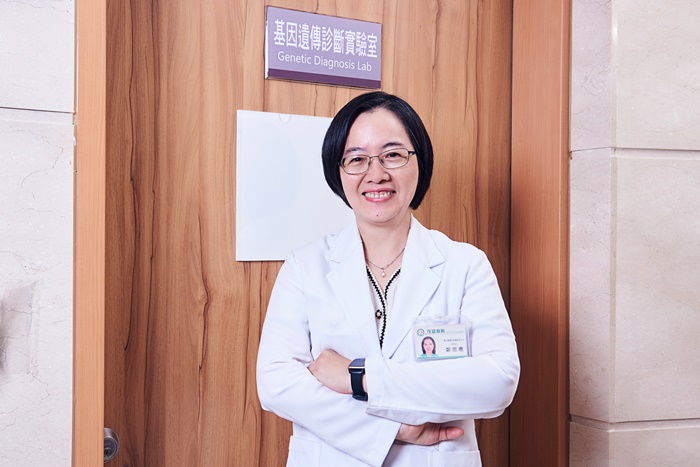
▲Director Dr. En-Hui Cheng, Lee Women's Hospital
No matter the cause of infertility, in vitro fertilization (IVF) has become a widely chosen path to parenthood. To improve the chances of a successful pregnancy, transferring healthy embryos is key. That's why screening embryos for chromosomal abnormalities plays such a vital role in reproductive medicine. But how exactly does a Genetic Diagnosis Laboratory carry out this crucial task and meet the growing needs of hopeful parents? Let's step inside the Genetic Diagnosis Laboratory at Lee Women's Hospital and take a closer look!
- Outsourced Testing Carries High Risks; Our In-House Lab Guarantees Quality Control.
- Addressing All Types of Infertility, Identifying Causes and Finding Solutions
- Highly Personalized Testing: Few in Number, Demanding in Precision
- Step Inside the Genetic Diagnosis Lab: A Look At How the Testing Works
As more and more couples turn to in vitro fertilization (IVF) to grow their families, awareness is also growing about the crucial role that embryo chromosomal health plays in pregnancy success. In particular, women who have experienced recurrent miscarriage, are of advanced maternal age, or have a family history of genetic conditions are often advised by their doctors to undergo preimplantation genetic testing (PGT) for chromosomal screening before embryo transfer.
So how does the Genetic Diagnosis Laboratory carry out this critical task?
Dr. En-Hui Cheng, Director of the Genetic Diagnosis Laboratory at Lee Women's Hospital, explains: “In most testing centers, samples typically consist of blood or buccal (cheek) cells. In contrast, our lab primarily works with embryo samples. In some cases, we also analyze amniotic fluid or chorionic villus samples from pregnancies conceived through IVF.”
High Risks in Outsourced Testing In-House Lab Ensures Quality Control
Dr. En-Hui Cheng explains, "Preimplantation genetic testing for chromosomal screening (PGT-A) involves performing a biopsy on embryos that have developed to Day 5 or Day 6. At this stage, the embryo contains over 100 cells. We carefully extract 5 to 10 cells from the trophectoderm the layer that will eventually form the placenta and analyze them using high-resolution next-generation sequencing (hr-NGS) to check for chromosomal abnormalities."
Selecting embryos without chromosomal abnormalities helps increase pregnancy and live birth rates while reducing the risk of miscarriage. Additionally, by transferring only chromosomally normal embryos, fewer embryos are needed per transfer, lowering the risk of multiple pregnancies.
She adds that in many fertility centers, embryo biopsies are sent to external laboratories for analysis. However, at Lee Women's Hospital, the Genetic Diagnosis Laboratory handles all testing in-house. "Quality control of the biopsy samples is crucial, she explains. "Any temperature fluctuations or physical impact during transport can compromise the sample quality for example, cells may stick to the sides of the test tube. In the past, we've seen cases where outsourced testing failed because the samples were damaged during transport. By performing the analysis in our own lab, we eliminate the risks associated with shipping and keep the process as safe and reliable as possible."
Dr. En-Hui Cheng emphasizes, "There is absolutely no room for error in any of these tests. High-quality, reliable testing is essential to helping patients achieve successful pregnancies. To ensure that our preimplantation genetic testing for aneuploidy (PGT-A) meets the highest international standards, our laboratory at Lee Women's Hospital was the first in Taiwan to receive ISO 15189 accreditation, a certification that is not easy to obtain.
She explains that achieving this certification required rigorous effort: "Every aspect of the laboratory must follow standardized protocols from staff training to equipment and reagent quality. Even the thermometers used to monitor laboratory conditions must be certified. While the process was complex and demanding, going through it gave us even deeper insight into how we can continue to enhance the quality of our lab."
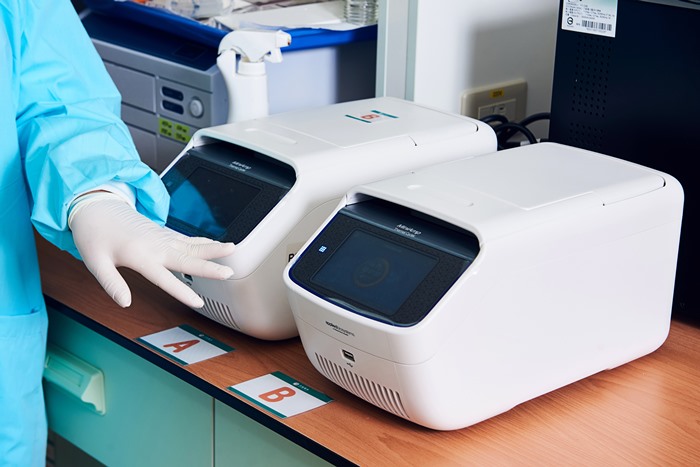
Animal Testing First, Then Applied to Humans
Dr. En-Hui Cheng shares, "Since the very beginning, Lee Women's Hospital has operated our own animal laboratory. In "A Life Catcher for the World”, the autobiography of the founder of the hospital, Dr. Maw-Sheng Lee, he explained the original purpose behind this initiative: "In reproductive medicine, every challenge, mechanism, and potential improvement must first be fully validated through animal studies before being applied to humans."
With this vision, when Lee Women's Hospital was established, it became the first not only in Taiwan but globally a private reproductive center to build an in-house animal laboratory.
To ensure accurate experimental results, Dr. Cheng explains, "We pay attention to every detail in our animal lab. The laboratory mice live in what we call 'six-star accommodations'. They have independent air circulation systems and drink only reverse osmosis (RO) purified water."
With the animal lab as a solid foundation, the reproductive team of Lee Women's Hospital has steadily advanced the lab's capabilities and scale, continuously developing new testing techniques and bringing fresh innovation to the field of reproductive medicine.
Addressing All Types of Infertility Identifying Causes and Finding Solutions
Lee Women's Hospital established its own Genetic Diagnostics Laboratory not merely to ensure testing quality, but also to advance both basic and clinical research in reproductive medicine and develop cutting-edge precision reproductive medicine testing technologies.
Dr. En-Hui Cheng explains, "When treating patients facing infertility caused by a wide range of issues, it's essential to identify the underlying causes and find solutions. Only then can we truly help them achieve a successful pregnancy."
Comprehensive Genetic Screening: PGT-A for Aneuploidy, PGT-M/PGT-SR for Inherited Conditions
For example, with preimplantation genetic testing for aneuploidy (PGT-A), according to international research, in many IVF treatments, embryos fail to implant because of chromosomal abnormalities. Thus, preimplantation genetic testing (PGT) was developed, and it is divided into: PGT-A (used when parents do not have known abnormal genes, to screen for chromosomal number abnormalities) and PGT-M/PGT-SR (targeted testing for known abnormal genes or chromosomes).
Dr. En-Hui Cheng compares chromosomes to a large tree. PGT-A checks whether there are 23 pairs of branches, meaning whether the number of chromosomes is normal or abnormal, and is mainly used for couples without known abnormal genes, such as women who have had multiple miscarriages or are of advanced maternal age; PGT-M/PGT-SR, on the other hand, checks whether the veins on a specific leaf are normal, and is used for couples with known abnormal genes or chromosomes.
She said, "In the past, people had many children. If you had ten and lost two, it didn't matter. But today, families have fewer children, and having one child with abnormalities can place a huge burden on the family and on society. If the abnormalities are caused by genetic diseases, they inevitably become a fate passed down through generations. Now, with precise embryo screening technology, it is possible to select embryos without genetic disease genes for implantation, making the dream of having a healthy baby no longer out of reach."
Dr. En-Hui Cheng gave an example: if both husband and wife carry the gene for thalassemia, there is a 1/4 chance that the fetus will develop a severe form of the disease, which may even result in stillbirth. In the past, such problems were only detected through amniocentesis performed on the pregnant woman, after which she would have to endure unbearable emotional pain. However, now parents known to carry genetic disease genes (such as SMA or hemophilia) can choose the IVF path and still have the chance to give birth to a healthy baby.
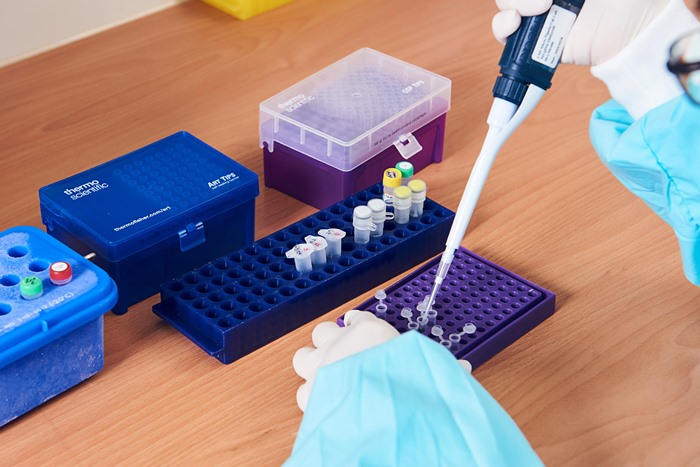
Understand the limitations of testing in advance
Dr. En-Hui Cheng adds that if both chromosomes of the same pair in the fetus carry abnormal genes, this may lead to miscarriage or the birth of a child with disease. The purpose of screening is to exclude carrier or affected embryos, not to remove a particular gene. Dr. Cheng reminds, "Before undergoing testing, it is essential to receive genetic counseling and understand that every test has its limitations. If there are spontaneous abnormalities (gene mutations that occur during embryo implantation and differentiation), these cannot be detected through pre-pregnancy testing based on the parents' family history."
In addition, disease screening cannot guarantee a completely healthy outcome. "This is because a pathogenic gene may not be caused 100% by a single A gene mutation site. Even if the A gene mutation site is screened out, there may still be other mutation sites in the A gene, or even problems in the B gene.
In particular, embryo biopsy only takes 5 to 10 cells, and the current testing limitations do not allow for whole-genome screening. Therefore, further tests such as amniocentesis or chromosomal microarray analysis are still needed to more comprehensively assess the health of the fetus.
Dr. En-Hui Cheng points out that currently, PGT-A testing accounts for about one-third of IVF procedures, while PGT-M/PGT-SR is more like a "customized test, offered to those with a known family history or who have undergone carrier screening and discovered abnormal genes. The number of people undergoing this test is relatively small, about 2-3%. "Some couples are not infertile but have genetic abnormalities and repeatedly give birth to children with inherited diseases. It is recommended that they switch to IVF, so that embryos with genetic abnormalities can be excluded from transfer, thereby ending the fate of passing on these genetic diseases from generation to generation."
Career Shift: Following Dr. Maw-Sheng Lee to Advance In Reproductive Medicine
Dr. En-Hui Cheng originally worked in cancer research but was recruited by Dr. Maw-Sheng Lee to join Lee Women's Hospital, where she began her journey in reproductive medicine. Since pregnancy is a life goal for many people, and Dr. Lee carries the hopes of many infertile couples who long for children and place high expectations on having a healthy baby, it inevitably puts a lot of pressure on the laboratory researchers. She admits that she was very nervous at first, but being overly concerned about success or failure does not help the work. "Genetics is a matter of probability. Being anxious along with the patients does not solve problems. I followed the guidance of the director and the doctors, taking things one step at a time, and learned to approach the work with a calm mind. Fortunately, when we encounter challenges, we have a strong team to tackle each obstacle together."
Although Dr. Cheng and her team do not work directly with patients, there was a time when a patient stopped her on the street and asked, "How is my test result? Even though she understood the patient's anxiety, she could not provide an answer on the spot. "Producing the test result is one thing, but it still requires review and verification it is not up to one person alone to decide."
Dr. Cheng reminds everyone that no matter where PGT testing is conducted, once the report is received, patients should first consult their doctor rather than searching online and interpreting the results on their own, which can easily lead to unnecessary worry. For more detailed understanding, she recommends visiting a genetic counseling clinic for professional guidance, so you can make the most informed and appropriate decisions.
Highly Personalized Testing: Few in Number, Demanding in Precision
Although only a few patients undergo customized testing, such as PGT-M/PGT-SR, it is the area where laboratory staff invest the most effort! Dr. En-Hui Cheng explains, "Each disease has different characteristics. First, we extract blood from the parents to determine whether the mutation site comes from the father or the mother, or if it involves homologous genes (meaning the same gene located at the same position on paired chromosomes). Based on the site, we then design probes. Once the probes are designed, we proceed with genetic testing and diagnosis of the embryos."
She says that this kind of work is extremely complex, with each case requiring several researchers to work together, progressing step by step, with each step taking a certain amount of time. "We face not only the pressure of research and development but also time pressure. We must complete the development within a specific timeframe, because patients are waiting for us to solve the problem so that they can have the chance to see hope emerge from despair."
It is worth mentioning that these tests are often charged at market rates externally, but at Lee Women's Hospital, for patients undergoing IVF, part of the testing cost (the cost of probe design) is absorbed by the hospital and not charged to the patient. Dr. En-Hui Cheng points out, "To help patients solve their problems, the director truly spares no expense. He leads us to actively participate in international conferences and study academic journals to learn about new technologies. When we encounter bottlenecks, we also seek assistance from domestic and international laboratories and even send staff abroad to learn."
She shares that there was once a time when, in order to find a solution to a particular problem, she flew a round-trip to Osaka within 24 hours.
Many infertile couples, after going through multiple IVF treatments without success, eventually come to Lee Women's Hospital, seeing it as their "Last hope for pregnancy." As a result, one-third of all IVF procedures in Taiwan are performed here. And Lee Women's Hospital has lived up to these expectations, having successfully helped many difficult cases fulfill their dream of becoming parents.
Thanks to the many challenging cases that come to Lee Women's Hospital for treatment and the continuous efforts of the team in research and development, our laboratory is now able to detect 36 common genetic diseases, with thalassemia being the most frequently detected. However, there are still many types of genetic diseases, and it is said that the director and vice director (Dr. Ming-Che Chen) have created a wish list, waiting for the laboratory staff to fulfill. It is foreseeable that the number of diseases that can be tested will continue to increase. In addition, the team is not only focusing on the development of single-gene testing, but is also working towards multi-gene testing, with the hope of helping infertile women successfully conceive and give birth through precision reproductive medicine testing.
PGT-M Custom Disease Testing Developed by Lee Women's Hospital (Number of Treatment Cycles)
| Category | Disease Name |
|---|---|
| Skeletal / Muscular | Marfan syndrome (1) Duchenne muscular dystrophy(2) Charcot-Marie-Tooth disease(1) Rickets(1) Ankylosing spondylitis(15) Spinal muscular atrophySMA (4) Kennedy disease(1) |
| Kidne | Polycystic kidney disease(6). Renal tubular dysgenesis(1) |
| Nervous System | Spinocerebellar ataxia type 3(6) Neurofibromatosis(2) Pompe disease(2) |
| Skin | Piebaldism(1) Incontinentia pigmenti(1) Ichthyosis(1) |
| Intellectual Development | Fragile X syndrome(3) Huntington's disease(1) |
| Metabolic System | Fabry disease(1) Glucose-6-phosphate dehydrogenase deficiency (G6PD deficiency)(1) Zellweger syndrome(1) Phenylketonuria (PKU)(1) Mitochondrial respiratory chain complex I deficiency(1) |
| Hearing | Hereditary hearing loss(9) Usher syndrome(1) |
| Visual System | Red-green color blindness(3) Visual impairment(1) Retinitis pigmentosa(1) |
| Hematologic System | Hemophilia A / B(3) Thalassemia major / minor(47) Cerebral cavernous malformation(1) Paroxysmal nocturnal hemoglobinuria(1) |
| Others | Orofaciodigital syndrome(1) PIGA gene mutation(1) Lynch syndrome(1) Cystic fibrosis(1) APC gene mutation(1) |
Step Inside the Genetic Diagnosis Laboratory See How the Testing Works
Now, let's follow Dr. En-Hui Cheng into the Genetic Diagnosis Laboratory and take a look at how the testing is done.
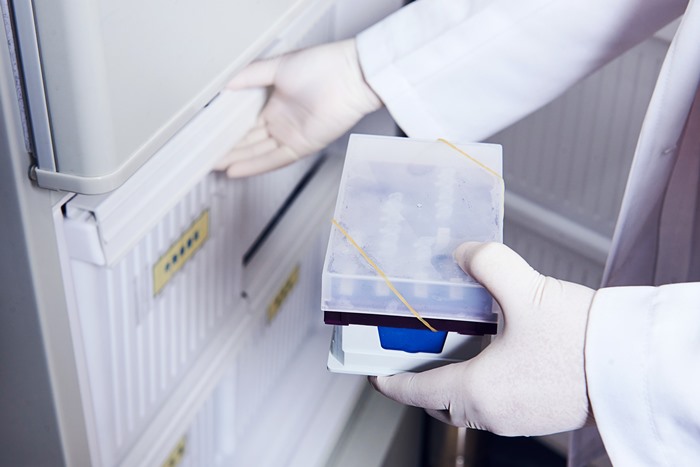
▲Sample Preservation: After embryo biopsy, the embryos must be stored in a transport box and kept frozen. The embryology lab transports the embryo samples to the laboratory using a cooler box that has been pre-frozen at -20℃ the day before.
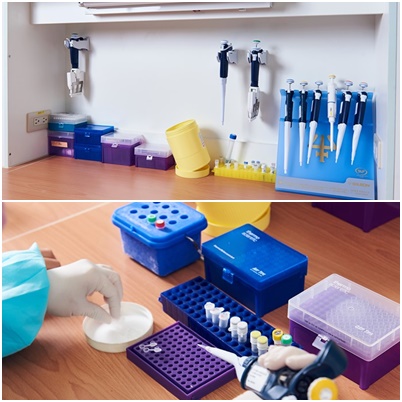
▲Sample Handling Area: Preparation of reagents and pre-processing of samples.
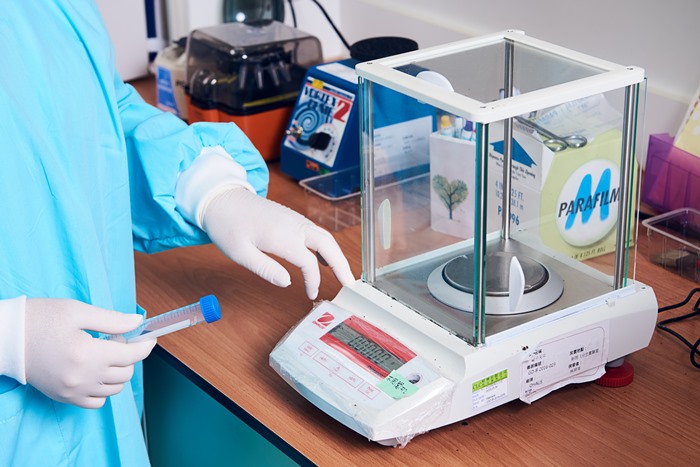
▲Electronic Balance: Some tests require reagent preparation; the electronic balance allows for accurate measurement of reagent quantities.
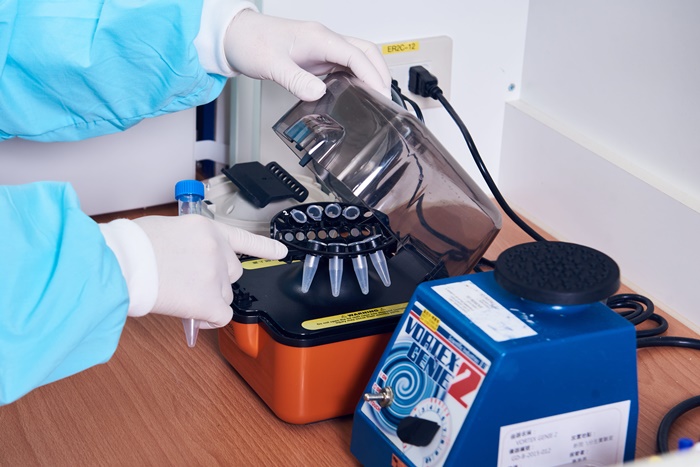
▲Centrifuge: After mixing the sample and reagents evenly, the centrifuge is used to spin the mixture so that the reaction reagents are precipitated to the bottom of the test tube, preventing the reagents from sticking to the tube walls and affecting test quality.
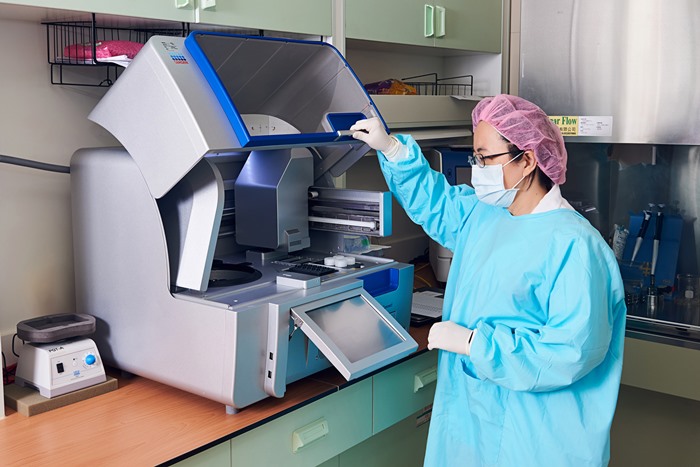
▲Automated DNA Extractor: For samples such as blood and amniotic fluid, this machine automatically adds reagents and extracts high-quality DNA. It can process 12 samples at the same time.
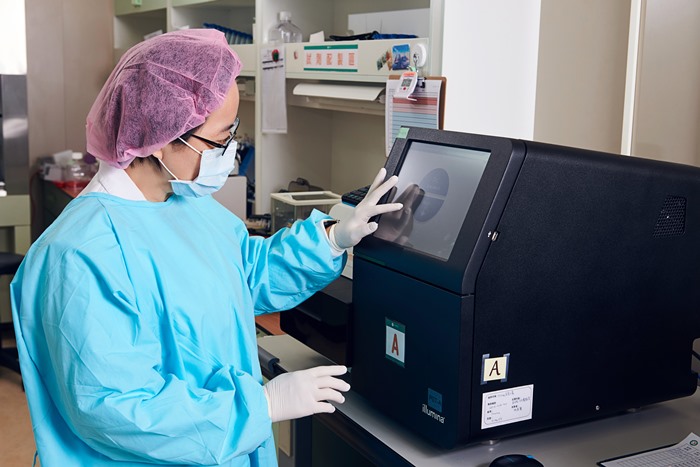
▲Next-Generation Sequencer: After amplifying the sample, it performs high-accuracy chromosomal sequence analysis (PGT-A).
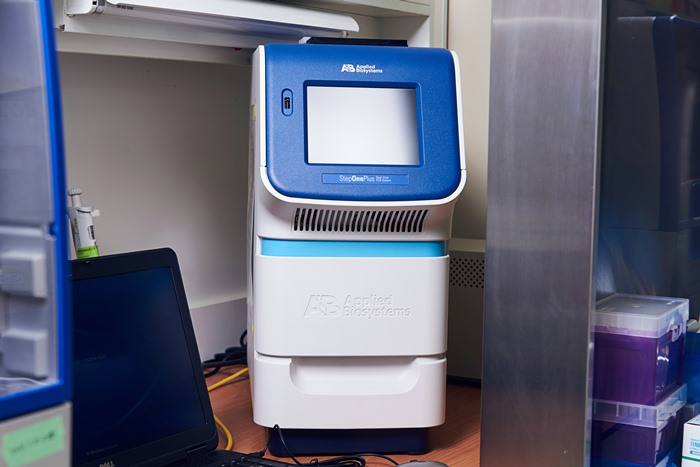
▲Real-Time Quantitative Polymerase Chain Reaction (qPCR) Machine: Provides early diagnosis of single-gene inherited diseases, allowing for assessment of the embryo's health status.
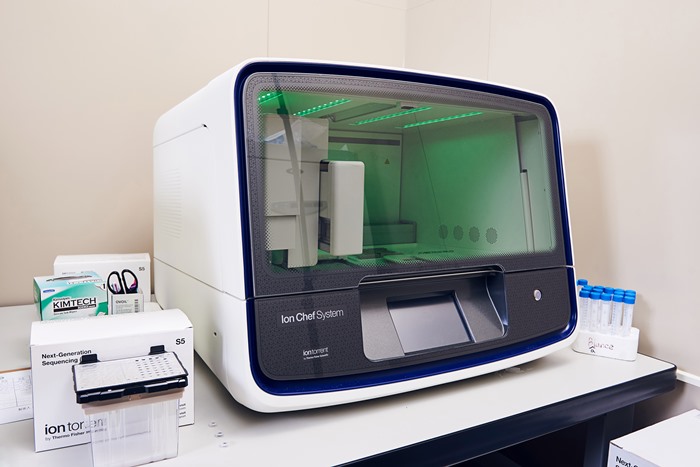
▲Next-Generation High-Throughput Sequencer (NGS): Determines sequences using the potential differences of different nucleotides.
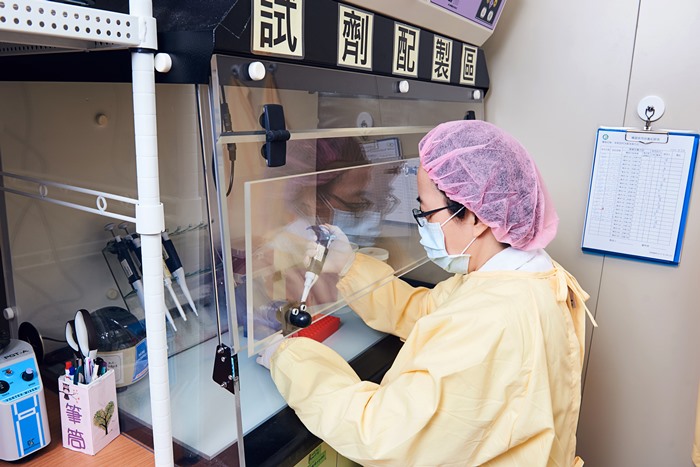
▲Reagent Preparation Area: Preparation of reagents for pre-processing embryo samples.
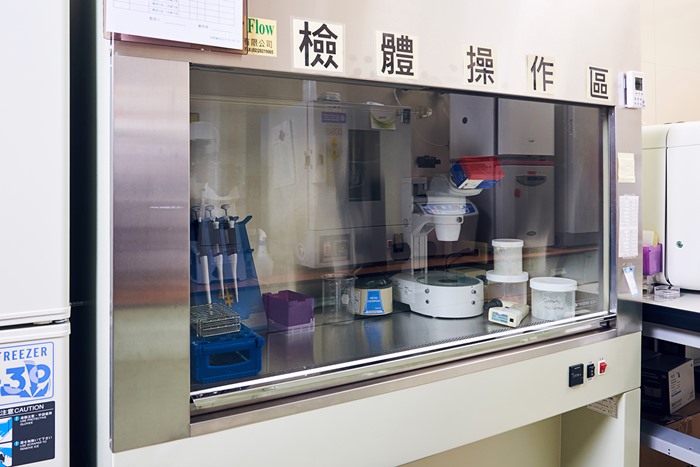
▲Sterile Operating Area: Sterile area for handling embryo samples or culturing embryonic stem cells.
Lastly, did you notice that Dr. En-Hui Cheng was wearing two different colors of lab coats?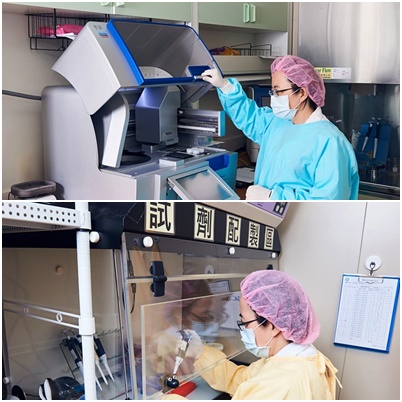 Entering the laboratory requires wearing a lab coat and a hair cap. To avoid contamination, different different-colored lab coats must be worn in different laboratory areas.
Entering the laboratory requires wearing a lab coat and a hair cap. To avoid contamination, different different-colored lab coats must be worn in different laboratory areas.
Source:Mombaby Magzine 2024/09/18




